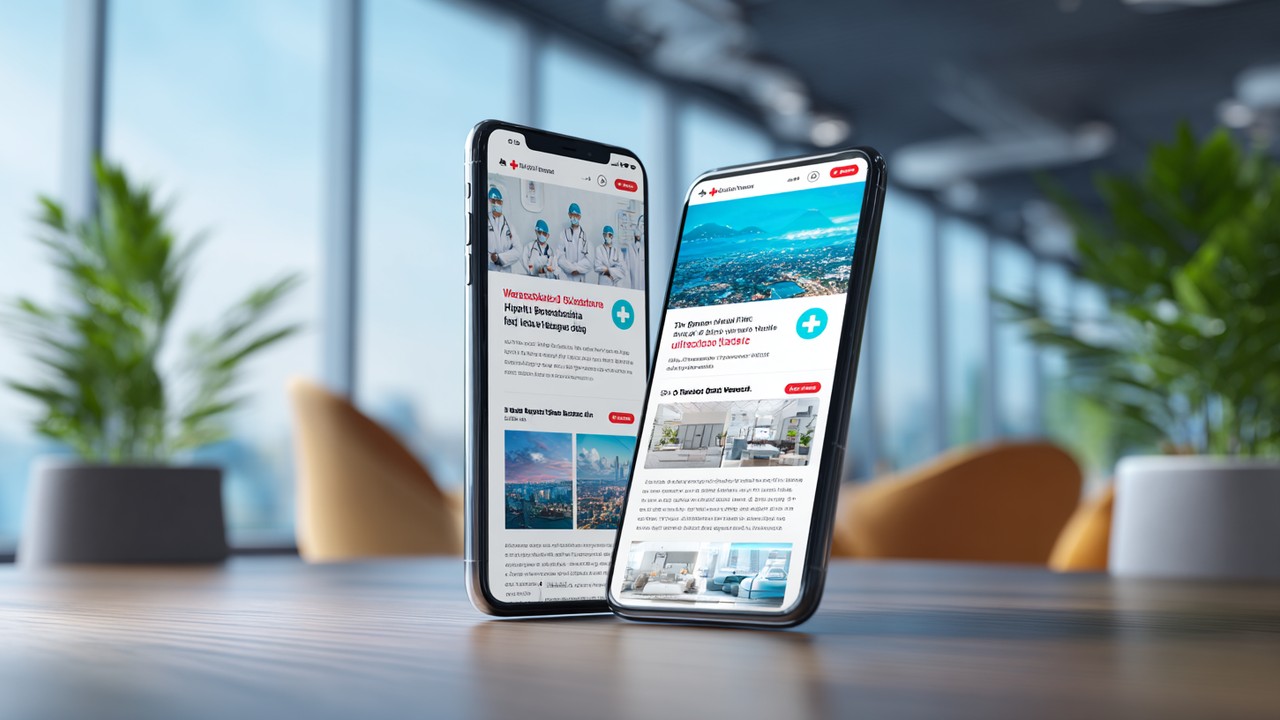Causes and Importance of Bounce Rate on Health Clinic Websites Health clinic websites serve as the first point of contact with patients, and therefore, the user experience on the site is a critical factor for the clinic's success. Bounce rate refers to the rate at which visitors leave the site without navigating to another page …
Causes and Importance of Bounce Rate on Health Clinic Websites
Health clinic websites serve as the first point of contact with patients, and therefore, the user experience on the site is a critical factor for the clinic's success. Bounce rate refers to the rate at which visitors leave the site without navigating to another page or taking any action after entering, and this metric is especially important in the healthcare sector. Because a high bounce rate carries the risk of losing potential patients' trust and experiencing a decline in appointment bookings.

The importance of bounce rate for health clinic websites goes beyond just measuring visitor numbers. Trust and the search for information are paramount in healthcare services; users quickly form opinions about the clinic's professionalism and reliability based on their first impressions on the website. Therefore, a high bounce rate indicates that patients do not find the site sufficiently useful or cannot access the information they need. This situation directly negatively impacts appointment booking processes and the preference for clinical services.
User behaviors and expectations are quite specific in the healthcare sector. Visitors generally seek fast, easily accessible, and reliable information. Uncertainty or complexity regarding health-related topics can cause users to leave the site. Additionally, technical issues, slow loading times, complex navigation structures, and the site’s outdated appearance are among the main factors that increase the bounce rate.
Common issues that increase bounce rate on health clinic websites include:
- Slow Page Loading Times: When patients are searching for urgent information, slow page loading causes impatience and leads to site abandonment.
- Complex Navigation: Difficulty in easily finding the desired information negatively affects the user experience.
- Lack of Trust: Insufficient information about the clinic, absence of certifications, user reviews, or trust symbols create hesitation among patients.
- Mobile Compatibility Issues: Difficulties accessing the site from mobile devices are a critical problem due to the increasing use of mobile internet today.
- Content Disorganization: Difficult-to-understand, lengthy, or outdated content is not preferred by visitors.
A high bounce rate on a health clinic website not only results in traffic loss but also damages patients' trust and loyalty to the clinic. Therefore, designing and optimizing the site to meet the needs of visiting users makes a significant difference in the digital success of clinics. Improving website performance and keeping visitors engaged directly contributes to increasing appointment booking rates and, consequently, clinic revenues.
Reducing Bounce Rate by Improving User Experience in Clinic Website Design
To increase the time visitors spend on a health clinic website, user experience (UX) must be prioritized and perfected. This is not just an aesthetic design but a holistic approach that combines functionality and accessibility. Modern users, especially in critical fields like healthcare, expect easy and fast access. The success of your clinic website depends on providing a smooth experience that ensures visitor satisfaction.
The Importance of Mobile Compatibility and Responsive Design
Today, the vast majority of internet users access websites via mobile devices. For a health clinic website, mobile compatibility is no longer a choice but a necessity. Responsive design ensures the site looks flawless and remains functional on all devices (smartphones, tablets, desktops).
Non-mobile-friendly sites cause visitors to leave the site quickly because the content appears broken, navigation becomes difficult, and page loading times increase. Therefore, ensuring mobile compatibility is one of the most effective ways to reduce bounce rate. At the same time, since Google applies mobile-first indexing in its search algorithms, it positively affects your SEO performance.

Speed Optimization: Technical Recommendations to Reduce Page Load Time
Site speed is one of the most critical factors in reducing bounce rate. For a health clinic website, visitors especially do not want to wait more than a few seconds for the page to load when trying to make an appointment or access urgent health information.
The following technical steps can be implemented to increase page load speed:
- Image Optimization: Reducing file sizes by optimizing clinic images significantly decreases loading time.
- Browser Caching: Caching site resources for returning users provides faster access.
- Improving Server Performance: Choosing a powerful hosting service and using a CDN (Content Delivery Network) increases site speed.
- JavaScript and CSS Minification: Removing unnecessary spaces from code lightens the page load.
These technical improvements increase users’ trust in the site and encourage them to stay longer on the site.
Creating a Clear and Easy Navigation Structure
The navigation of the clinic website should make it easy for visitors to find the information they are looking for and be free of confusion. Organizing menus in a hierarchical and logical order prevents users from getting lost within the site.
- Main services, doctor information, appointment booking, and other important sections should be accessible within a few clicks.
- Using a sticky menu at the top of the site provides quick access.
- Adding a search bar makes it easier for users to directly reach specific information.
A navigation design that is eye-catching yet simple ensures visitors can find the information they need without leaving the site.
Visual and Content Balance: Professional Images Reflecting the Clinic’s Image and Readable Texts
The healthcare sector is built on the perception of trust and professionalism. The images used on the clinic website should leave a positive and reliable impression in patients’ minds. High-quality, professionally taken photos and visual materials emphasize the clinic’s expertise and modernity.
Additionally, the readability and clarity of the content are very important. Long texts filled with technical terms can tire visitors. Instead;
- Short and clear explanations,
- Spaces between headings and paragraphs,
- Using bulleted lists to make content easy to digest,
should be employed.
This balance helps visitors spend more time on the site.
Designing User-Friendly Appointment Booking and Contact Forms
One of the most important functions of a health clinic website is to establish an effective communication channel between the patient and the clinic. Appointment booking and contact forms should allow users to complete transactions easily without leaving the site.
- Simple and short forms should be designed so users can fill them out quickly.
- Required fields should be clearly indicated, and unnecessary form fields should be avoided.
- Forms should be mobile-compatible, allowing easy completion on any device.
- Providing instant confirmation messages to users after form submission increases the sense of trust.
These kinds of user-friendly design elements are effective in increasing patient conversions and reducing bounce rate. When users find the appointment booking process easy and fast on a health clinic website, it strengthens their loyalty to the site and establishes a healthy communication bridge between the clinic and the patient.
Methods to Keep Visitors on the Site with a Health Clinic Content Strategy
One of the most effective ways to reduce the bounce rate on a health clinic website is to develop patient-centered, informative, and trust-enhancing content strategies. Users need accurate and understandable information on health-related topics; therefore, content should not only serve SEO purposes but also answer patients' questions, alleviate their concerns, and provide clear information about clinic services.
Preparing Patient-Centered, Informative, and Trust-Enhancing Content
When producing content, the priority is to meet visitors' expectations and reinforce their sense of trust. In the healthcare sector, users tend to prefer content prepared in a clear, simple language instead of medical jargon. Therefore, texts on the clinic website should;
- Offer solutions to common health problems patients face,
- Clearly state the advantages of clinic services and areas of expertise,
- Provide detailed but understandable information about treatment processes, doctor profiles, and technologies used.
Additionally, content should include elements that increase patients' trust. For example, items such as doctors' specialty certificates, clinic certifications, patient testimonials, and success stories increase visitors' loyalty to the site and reduce the bounce rate.
Meeting User Needs with Frequently Asked Questions (FAQ) and Health Guides
Many health-related topics that users are curious about are key points where they want quick answers from the site. The FAQ section directly addresses this need while also encouraging visitors to spend more time on the site.
- Practical information such as clinic services, appointment booking processes, and payment options should be included in the FAQ.
- Health guides provide detailed and up-to-date information about specific diseases, treatment methods, or preventive health recommendations.
- These guides help users see the site as a reference source and encourage repeat visits.
This strategy ensures quick answers to visitors' questions and increases the site's authority, helping it be valued more by search engines.
Driving Regular Traffic to the Site with a Blog and Current Health News
Creating a blog section on the clinic website is a powerful method to ensure visitors return regularly. Topics such as current health news, new treatment methods, seasonal illnesses, and healthy living tips attract patients' interest and keep site traffic active.
- Regular and original content production contributes to improving search engine rankings.
- Blog posts should be naturally optimized with relevant keywords like “health clinic,” “appointment booking,” and “hospital services.”
- Interactive content where users can comment and ask questions enriches the user experience on the site.
This content diversity encourages visitors to spend more time on the site and significantly reduces the bounce rate.
Increasing Engagement with Videos and Visual Content
Visual and video content are more effective than text-based content in capturing users' attention and helping them grasp information more quickly. For a health clinic website;
- Short videos prepared as doctor interviews, explanations of treatment processes, or patient experiences,
- Informative graphics, infographics, and photos,
- Introductions to modern devices used within the clinic,
keep visitors' interest alive and increase the time spent on the site.
Video content is especially popular among mobile users and contributes to clinic promotion thanks to its shareability on social media. Content supported by visual elements strengthens the professional image of the health clinic and reinforces users' trust in the site.
Keyword Optimization: Natural Use of LSI Terms Like “Health Clinic,” “Appointment Booking,” “Hospital Services”
Targeting only keywords is not enough for SEO success; relevant and semantically coherent LSI (Latent Semantic Indexing) terms must also be naturally integrated into the content. On health clinic websites, along with keywords like “health clinic,” “appointment booking,” “hospital services”;
- Treatment options,
- Specialist doctors,
- Patient satisfaction,
- Emergency health services,
synonymous and related terms should be used in a balanced and fluent manner within the content. This approach helps search engines perceive the content as comprehensive and user-focused, thereby increasing organic traffic and reducing bounce rates.
With the right keyword and content strategy, a health clinic website enables users to easily access the information they seek and ranks higher in search engines, attracting more visitors. Thus, visitors spend more time on the site and appointment booking conversions increase.
Monitoring and Improving Bounce Rate with Technical SEO and Analytics Tools
To effectively manage the bounce rate on health clinic websites, it is not enough to only make design and content improvements. The use of technical SEO and data analysis tools is crucial for continuously monitoring site performance, detecting issues early, and producing solutions. This way, both user experience is optimized and lasting success in search engine rankings is achieved.
Tracking Bounce Rate with Google Analytics and Other Analysis Tools
Google Analytics is one of the most commonly used tools for monitoring website performance. Such analysis tools are indispensable for measuring and interpreting the bounce rate on a health clinic website.

- Seeing which pages visitors leave quickly helps understand user behavior.
- Identifying from which sources (e.g., organic search, social media, direct access) more exits occur allows marketing strategies to be shaped accordingly.
- Performance analysis can be done based on visitor segments (such as mobile and desktop users).
This data forms the basis for identifying areas that need improvement on the clinic website. Additionally, by tracking how visitors navigate the site, concrete steps can be taken to enhance on-page experience.
Using Heatmaps and Session Recordings to Understand User Behavior
Heatmaps show which areas visitors click on the most, where they pause, and which sections they ignore on a page. On a health clinic website, this data helps identify content that attracts or repels users.
- For example, it can be detected if appointment booking buttons are not visible enough or if users struggle with form fields.
- Session recordings show step-by-step how real users navigate the site, allowing direct observation of navigation problems and technical issues.
These analyses enable design and content strategies to be revised with a user-centered approach and play an important role in reducing the bounce rate.
Technical SEO Improvements to Boost Page Performance (Meta Tags, Schema Markup, Site Speed)
Technical SEO ensures that a health clinic website is easily crawled by search engines and loads quickly. Improvements in this area positively impact both user experience and SEO rankings.
- Meta Tags: Page title and meta description tags attract users' attention in search results. Unique and descriptive meta tags should be prepared for each page.
- Schema Markup: Structured data such as clinic information, doctor profiles, and appointment options are marked up with schema markup to help search engines better understand the content. This creates rich snippets and increases click-through rates.
- Site Speed: The previously mentioned speed optimization techniques maximize page performance. Sites compliant with Google's speed criteria gain an advantage in search engine rankings.
These technical improvements ensure that the health clinic website is easily accessible and understandable by both users and search engines.
Measuring the Impact of Different Designs and Content with A/B Testing
A/B testing is a critical method to understand the effectiveness of changes made to reduce the bounce rate. Different design or content versions are created on the clinic website, and users are randomly directed to these versions to analyze which performs better.
- For example, user response rates can be measured by changing the color, position, or text of the appointment booking button.
- Different versions of content headlines or image usage can be compared to determine which type of content visitors are more interested in.
These tests enable data-driven decisions to systematically improve user experience and conversion rates.
Continuous Improvement Processes to Reduce Bounce Rate
Reducing the bounce rate on a health clinic website is not a one-time effort. It requires continuous monitoring, analysis, and improvement.
- User feedback should be regularly collected and updates made on the site.
- Trends and changes in user behavior should be closely followed, and content and design strategies updated accordingly.
- Technical SEO and performance optimization should be reviewed periodically.
This continuous improvement approach ensures that the health clinic website remains user-friendly and competitive at all times. Thus, the rate at which visitors leave the site is kept under control, and clinic appointment conversions are maximized.





